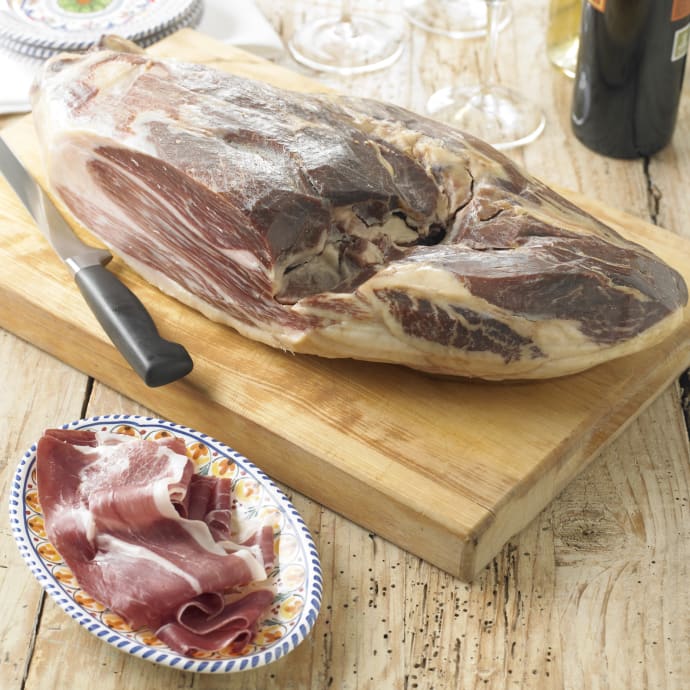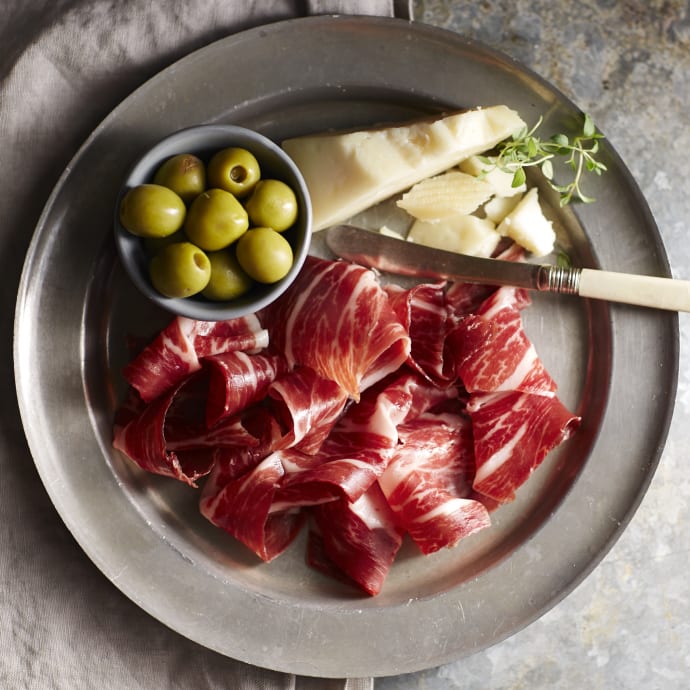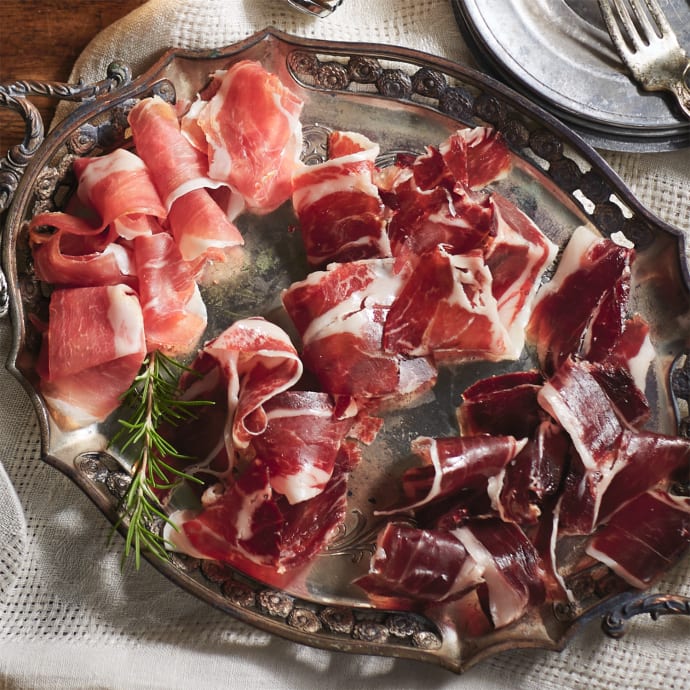Order by 12/23 for Delivery by Christmas! Shop Gift Guide

Premium Pork
The New York Sun
-
March 29, 2006
Paul Lukas
From condiments to main courses, most food subcultures have their holy grails. Kobe beef, Beluga caviar, o-toro sushi, fleur de sel, Johnnie Walker Blue Label - each of these is a super-premium product that represents the acme of its particular category.
For pork products, the holy grail is pata negra - the highly prized, fabulously expensive Spanish ham that's so hearty and rich, so magnificently delectable, it makes Italian prosciutto taste like Boar's Head.
Or at least that's what you always hear. Most Americans have had to take this on faith, because there's no way to sample pata negra here - not legally, at least. All meat imported into America must be processed at slaughterhouses that meet U.S. Department of Agriculture standards, and the small Spanish abattoirs where pata negra is produced have been unwilling to make the investments needed to bring their facilities up to spec. So although this delicacy is enjoyed throughout Europe and other parts of the world, it's been unavailable in America.
That's soon going to change.In a development that rocked the food world (okay, the world of obsessive food geeks), a Virginia food importer called La Tienda announced last September that it had reached an agreement with the Spanish and American governments to certify the first USDA-approved slaughterhouse and curing facility in Spain, making pata negra eligible for export to America for the first time.
There's a catch: One reason pata negra tastes so good is that it cures for at least two years (there are other reasons as well, which we'll get to in a minute). So the first hams for American export won't be ready to ship until late 2007 or early 2008. But that hasn't kept several hundred enthusiasts from reserving whole bone-in hams for themselves by putting down $200 deposits at La Tienda's Web site tienda.com. If that sounds like a lot of money for a deposit, get this: The final price will be about $60 a pound, which means each ham will cost somewhere between $800 and $1,000, depending on its weight. High on the hog, indeed.
What makes pata negra so expensive, and so delicious? There are three primary components:
* The pigs. Pata negra - which means "black leg" - is produced exclusively from a rare breed of black-hoofed iberico hogs that have roamed southern Spain for centuries. Much like Wagyu steer - the cattle used for Kobe beef - these pigs feature a high degree of intramuscular fat marbling, which is a key flavor determinant. Iberico pigs tend to have very small litters, which helps explain why pata negra is so pricey - there's a builtin scarcity factor. Because cross-breeding can increase litter yields, Spanish law now specifies that pata negra can come from cross-bred pigs as long as they have at least 75% iberico blood. The president of La Tienda, Don Harris, said the flavor difference between the cross-bred pigs and 100% purebloods is "very little."
* Care and diet. The pigs are allowed to roam freely over several acres, feeding primarily on acorns from cork oak trees.The acorns give the finished product a complex earthiness not found in other hams. Moreover, cork oak groves are relatively small and rare, which creates yet another production ceiling that adds to the ham's price and mystique. And in a nice side benefit, the acorn diet increases the ham's level of oleic acid, the unsaturated fat that lowers "bad" cholesterol and raises "good" cholesterol. In other words, pata negra may be the world's most expensive health food.
* Curing. After the pigs are slaughtered (or "sacrificed,"as the Spaniards prefer to say),the rear legs are salted and hung to air-cure, usually for at least two years and sometimes as long as three, which is much longer than for Italian prosciutto or American country hams.This concentrates the meat's flavor - and, because time is money, further adds to its price.
"Okay," you're thinking. "That's interesting, but how does it taste? Is it really worth it?" Until recently, I couldn't have answered these questions because I hadn't been overseas since becoming aware of pata negra. But last month I visited a friend in London and made a point of visiting the wonderful Borough Market, where pata negra was at the top of my shopping list. I was just explaining the situation to my British friend - the acorns, the extra-long cure, the whole deal - when, as if on cue, we came upon a vendor's stall with a sign that read,"Spanish Hams."
I approached the clerk and asked if they had pata negra. She gestured toward an entire pig's leg - black hoof and all - mounted horizontally in a metal slicing rack. The price was L15 for 100 grams, or about $130 a pound. Fortunately, there was no minimum, so I asked for L10 worth and watched, rapt, as she slowly hand-carved several paper-thin, translucent slices. It was oddly compelling, like watching a performance. Every now and then she'd break the spell by cutting off a small scrap and offering it for us to taste. It was good - very good.
Later, at my friend's flat, we unwrapped the ham, which looked pretty much like prosciutto. As the clerk had instructed us, we ran a serving plate under hot water, dried it, and then let the ham sit on the plate for a minute or two, so that the warm surface would begin to melt the ham's fat, creating a richer, creamier effect.Then we began to eat.
It's always tricky to eat something that's supposed to be life-altering, because the food's reputation, and the resultant mental drum-roll of anticipation, recontextualizes the experience. How much of what you're tasting is based on your expectations? How much is based on not wanting to be the one person who "doesn't get it"? How much is based on wanting to justify the expense? (And if the food is disappointing, how much of that is based on the inevitable letdown that comes when the bar of expectations has been set impossibly high?)
All these caveats notwithstanding, I can honestly say I found pata negra to be worth the hype. The flavor is both nutty and buttery, with a mild saltiness that provides just the right counterpoint. And the texture seems to evolve from meaty to melty with each chew.
Life-altering? Not quite. But definitely life-enhancing. I'm already counting the days until those first hams are ready for export.
From condiments to main courses, most food subcultures have their holy grails. Kobe beef, Beluga caviar, o-toro sushi, fleur de sel, Johnnie Walker Blue Label - each of these is a super-premium product that represents the acme of its particular category.
For pork products, the holy grail is pata negra - the highly prized, fabulously expensive Spanish ham that's so hearty and rich, so magnificently delectable, it makes Italian prosciutto taste like Boar's Head.
Or at least that's what you always hear. Most Americans have had to take this on faith, because there's no way to sample pata negra here - not legally, at least. All meat imported into America must be processed at slaughterhouses that meet U.S. Department of Agriculture standards, and the small Spanish abattoirs where pata negra is produced have been unwilling to make the investments needed to bring their facilities up to spec. So although this delicacy is enjoyed throughout Europe and other parts of the world, it's been unavailable in America.
That's soon going to change.In a development that rocked the food world (okay, the world of obsessive food geeks), a Virginia food importer called La Tienda announced last September that it had reached an agreement with the Spanish and American governments to certify the first USDA-approved slaughterhouse and curing facility in Spain, making pata negra eligible for export to America for the first time.
There's a catch: One reason pata negra tastes so good is that it cures for at least two years (there are other reasons as well, which we'll get to in a minute). So the first hams for American export won't be ready to ship until late 2007 or early 2008. But that hasn't kept several hundred enthusiasts from reserving whole bone-in hams for themselves by putting down $200 deposits at La Tienda's Web site tienda.com. If that sounds like a lot of money for a deposit, get this: The final price will be about $60 a pound, which means each ham will cost somewhere between $800 and $1,000, depending on its weight. High on the hog, indeed.
What makes pata negra so expensive, and so delicious? There are three primary components:
* The pigs. Pata negra - which means "black leg" - is produced exclusively from a rare breed of black-hoofed iberico hogs that have roamed southern Spain for centuries. Much like Wagyu steer - the cattle used for Kobe beef - these pigs feature a high degree of intramuscular fat marbling, which is a key flavor determinant. Iberico pigs tend to have very small litters, which helps explain why pata negra is so pricey - there's a builtin scarcity factor. Because cross-breeding can increase litter yields, Spanish law now specifies that pata negra can come from cross-bred pigs as long as they have at least 75% iberico blood. The president of La Tienda, Don Harris, said the flavor difference between the cross-bred pigs and 100% purebloods is "very little."
* Care and diet. The pigs are allowed to roam freely over several acres, feeding primarily on acorns from cork oak trees.The acorns give the finished product a complex earthiness not found in other hams. Moreover, cork oak groves are relatively small and rare, which creates yet another production ceiling that adds to the ham's price and mystique. And in a nice side benefit, the acorn diet increases the ham's level of oleic acid, the unsaturated fat that lowers "bad" cholesterol and raises "good" cholesterol. In other words, pata negra may be the world's most expensive health food.
* Curing. After the pigs are slaughtered (or "sacrificed,"as the Spaniards prefer to say),the rear legs are salted and hung to air-cure, usually for at least two years and sometimes as long as three, which is much longer than for Italian prosciutto or American country hams.This concentrates the meat's flavor - and, because time is money, further adds to its price.
"Okay," you're thinking. "That's interesting, but how does it taste? Is it really worth it?" Until recently, I couldn't have answered these questions because I hadn't been overseas since becoming aware of pata negra. But last month I visited a friend in London and made a point of visiting the wonderful Borough Market, where pata negra was at the top of my shopping list. I was just explaining the situation to my British friend - the acorns, the extra-long cure, the whole deal - when, as if on cue, we came upon a vendor's stall with a sign that read,"Spanish Hams."
I approached the clerk and asked if they had pata negra. She gestured toward an entire pig's leg - black hoof and all - mounted horizontally in a metal slicing rack. The price was L15 for 100 grams, or about $130 a pound. Fortunately, there was no minimum, so I asked for L10 worth and watched, rapt, as she slowly hand-carved several paper-thin, translucent slices. It was oddly compelling, like watching a performance. Every now and then she'd break the spell by cutting off a small scrap and offering it for us to taste. It was good - very good.
Later, at my friend's flat, we unwrapped the ham, which looked pretty much like prosciutto. As the clerk had instructed us, we ran a serving plate under hot water, dried it, and then let the ham sit on the plate for a minute or two, so that the warm surface would begin to melt the ham's fat, creating a richer, creamier effect.Then we began to eat.
It's always tricky to eat something that's supposed to be life-altering, because the food's reputation, and the resultant mental drum-roll of anticipation, recontextualizes the experience. How much of what you're tasting is based on your expectations? How much is based on not wanting to be the one person who "doesn't get it"? How much is based on wanting to justify the expense? (And if the food is disappointing, how much of that is based on the inevitable letdown that comes when the bar of expectations has been set impossibly high?)
All these caveats notwithstanding, I can honestly say I found pata negra to be worth the hype. The flavor is both nutty and buttery, with a mild saltiness that provides just the right counterpoint. And the texture seems to evolve from meaty to melty with each chew.
Life-altering? Not quite. But definitely life-enhancing. I'm already counting the days until those first hams are ready for export.
Other Press
The Winter Travel Shortlist: Problem-Solving Essentials I’m Packing This Season
Forbes
-
November 20, 2025
54 Gifts for People Who Have Everything
Wirecutter
-
November 6, 2025
What Andrew Zimmern Can’t Live Without
The Strategist
-
June 30, 2025
8 Tasty Ways To Travel The World With Food
Forbes
-
June 17, 2025
Featured Products
 SHIPS FREE
SHIPS FREECinco Jotas Bone-In 100% Ibérico de Bellota Jamón - FREE SHIPPING!
JM-106
(4)
$1,599.00$1,599.00
 SHIPS FREE
SHIPS FREEBone-In Jamón Ibérico Ham by Fermín - FREE SHIPPING!
JM-11
(9)
$799.00$799.00
 SHIPS FREE
SHIPS FREEBoneless Jamón Ibérico Ham by Fermín - FREE SHIPPING!
JM-12
$799.00$799.00
 BEST SELLER
BEST SELLERSliced Ibérico de Bellota Ham by Peregrino, Nitrate Free - 2 oz
JM-52
(47)
$42.00$42.00
 BEST SELLER
BEST SELLERSliced Ibérico Ham by Peregrino, Nitrate Free - 2 oz
JM-23
(38)
$28.00$28.00
 BEST SELLER
BEST SELLERCured Meats of Spain Sampler
JM-45
(38)
$109.00$109.00
 BEST SELLER
BEST SELLERJamón Tasting Trio of Sliced Ham
JM-25
(36)
$85.00$85.00







